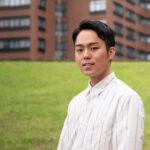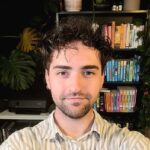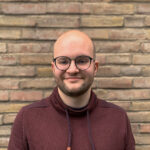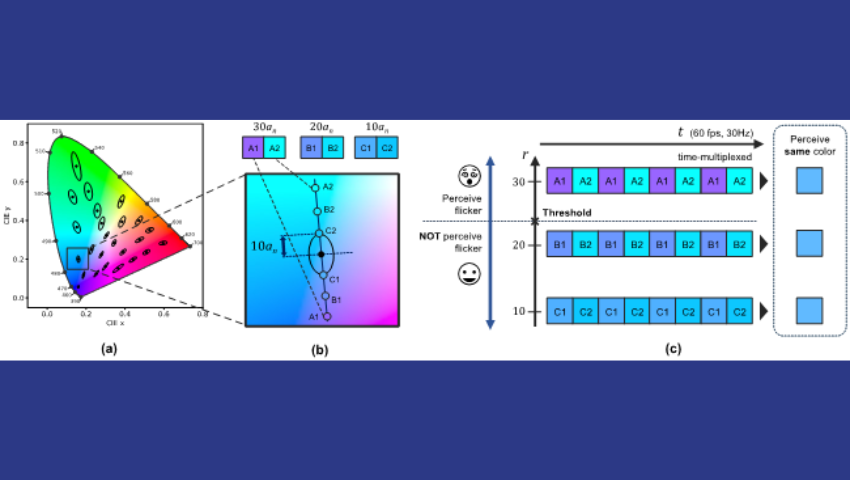Image credit: Shingo Hattori, Yuichi Hiroi and Takefumi Hiraki, Cluster Metaverse Lab.
Congratulations to the winners of the SIGGRAPH 2024 Student Research Competition, Shingo Hattori (first place, undergraduate), Vaya Simeonova (second place, undergraduate), Jolie Che, (third place, undergraduate), Samuel Zühlke (first place, graduate), Aleksander Płocharski (second place, graduate), and Moritz Heep (third place, graduate), for showcasing their exceptional skills and innovation in the field of computer graphics and interactive techniques. Now, let’s delve deeper into the remarkable achievements of these emerging professionals.
SIGGRAPH: Congratulations on being one of the winners of the SIGGRAPH 2024 Student Research Competition! Tell us about what inspired the idea behind your Poster and research.
Shingo Hattori (SH): The inspiration for my idea came from discussions and research into human color perception. My research focuses on determining the threshold at which two rapidly alternating colors on a display are perceived as either a single-fused color or as a flickering effect. This was based on experimental studies with human subjects.
Previously, we would attempt to predict human perception based on RGB channel values after generating two colors for display. However, this method didn’t provide a clear understanding of actual human perception. While investigating and discussing this issue of human color perception, I learned about the MacAdam ellipses.
The MacAdam ellipses represent how well humans can distinguish between colors when they are physically placed side by side. However, it was unclear how this would translate to colors alternating rapidly over time. This gap in knowledge intrigued me, and I decided to explore it in my research.
Vaya Simeonova (VS): Thank you so much! The idea behind my poster, “O, What an Iridescent Web We Weave: Rendering Physically Inspired Spider Webs for Visual Effects,” was sparked by a photograph I stumbled upon of a spider web with iridescent fibres. This rare natural phenomenon captivated me, and I realized that such subtle details are often overlooked in CG scenes, even though they can significantly enhance realism and add character to environments. As an environment artist, I saw the potential for spider webs to create more immersive scenes, particularly in urban settings. The challenge of replicating this delicate and impactful detail in a practical, efficient manner for VFX production guided my research.
Samuel Zühlke (SZ): Thank you! The inspiration for the TexEdge approach came from a confluence of my interests in interaction design, textile sensors, and machine learning. I’ve always been fascinated by how technology can blend seamlessly with everyday materials, particularly textiles, to create intuitive and adaptable interfaces. By combining textile surfaces with machine learning, I envision a way to create flexible, user-friendly interfaces that can be tailored to various applications, from controlling devices to enhancing accessibility in smart environments.
Aleksander Płocharski (AP): Thank you! I’m incredibly honored to be recognized at such a prestigious event. The inspiration for my research came from observing how procedural methods for architecture had been extensively explored until about a decade ago, when the field seemed to reach a plateau — most of what could be done had been done. However, a persistent challenge remained across all procedural frameworks, not just in building design: accessibility. Writing procedural rules is time-consuming and requires significant expertise. While some attempts, like inverse procedural methods, have tried to address these challenges, they come with their own limitations. With the recent boom in neural methods, I saw an opportunity to reignite this field. I believed that neural techniques could be the missing piece to overcome these hurdles, which led me to develop a neurosymbolic model for creating procedural definitions of building facades, detailed in my poster.
Moritz Heep (MH): My main research focuses on photometric stereo, i.e., the retrieval of surface normals from images under varying light conditions. In this context, shadows are a double-edged sword: On the one hand, they complicate the photometric stereo process. On the other hand, they reveal additional information about the spatial structure of the scene. The idea behind our poster was to investigate this connection more systematically.
SIGGRAPH: What was the most challenging aspect you encountered while conducting or analyzing your research study for the competition? How did you overcome it?
SH: The most challenging aspect of my research was conducting subject experiments on rapidly alternating colors. Perception varied between central and peripheral vision, and factors like display calibration and lighting conditions influenced results. To address these challenges, I sought advice from experienced co-authors. We implemented strict protocols for display calibration, controlled lighting, and developed a methodology accounting for vision differences. This collaborative approach allowed us to overcome challenges and gain meaningful insights into human color perception of rapidly alternating stimuli. Through this process, I significantly improved my skills in designing and executing complex perceptual experiments.
VS: The most challenging aspect of my research was maintaining high level of realism in the iridescence of the spider web without compromising the computational efficiency of the process for standard VFX production pipelines. Many existing methods for rendering fine fibres are either too complex or cannot be easily integrated for practical use. To overcome this, I experimented with different approaches and renderers, refining the process through trial and error. The goal was to make the technique both physically accurate and accessible for artists.
SZ: One of the most challenging aspects I encountered in my previous work was optimizing the placement of sensors on flexible textile surfaces. Textiles, by nature, are prone to stretching and flexing in different ways, making it difficult to ensure consistent and accurate sensor readings depending on the interaction. This challenge highlighted the need for a more sophisticated approach to sensor placement and data collection. In response, the TexEdge approach was developed as a solution to this problem. By incorporating a simulation process that runs simultaneously with machine learning classification, TexEdge will allow us to optimize both sensor placement and the accuracy of gesture recognition before even creating the physical prototype. In essence, TexEdge emerged as the answer to the challenges faced in earlier projects, providing a more refined and adaptable framework for working with textile sensors.
AP: One of the inherent challenges of research is the uncertainty — it’s impossible to know in advance whether your approach will succeed because it hasn’t been done before. Every project inevitably hits those moments when things aren’t going as planned, and doubts begin to surface: “What if this doesn’t work out after all?” Overcoming these lows was definitely a significant challenge for me. However, the pressure of an impending deadline — especially one as prestigious as SIGGRAPH — provided the motivation I needed to push through and keep going.
MH: We started this project with the insight that shadows under varying lighting conditions contain spatial information but can also be deceptive and lead to over-segmentation due to a fair number of false-positive contours. Ironically, the filtering approach we used to eliminate these false positives created the opposite problem: Contours are typically not water-tight and we had to develop an algorithm to close these incomplete contours.
SIGGRAPH: As a student excelling in the field, what specific areas within computer graphics are you keen on exploring and learning more about in the future?
SH: In the future, I’m particularly keen on delving deeper into the field of perception of displayed images. I’m especially intrigued by my current work on effectively embedding information into images to facilitate better coexistence between humans and machines. For instance, there’s potential to incorporate information into visuals that’s imperceptible to humans but recognizable by machines, which could lead to more natural applications of AR, VR technologies, and robot control.
My goal is to design more intuitive interfaces and create visual experiences tailored to individual perceptual characteristics. Ultimately, I aspire to contribute to a future where humans and machines can coexist seamlessly.
VS: I’m keen to explore iridescence on other surfaces, such as mica (the shiny flakes on rocks) and the inner layers of seashells, as well as glass caustics. These surfaces present unique challenges in rendering, and I’m excited to delve into the complexities they offer.
SZ: In the future, I’m particularly interested in the intersection of computer graphics and immersive technologies, especially for enhancing accessibility and adaptability for neurodiverse individuals. The potential to create rich, interactive environments tailored to diverse needs is immense. Specific areas I’m keen to explore include gesture and motion detection, image recognition, task prediction, and generative adaptive user interfaces combined into an entire system. I’m excited to explore how computer graphics can be leveraged to create more personalised and adaptable environments in the context of IOT and smart homes, making technology more accessible and responsive to individual needs.
AP: One area I’m particularly interested in exploring further is animation. I’ve always been a huge fan of traditional animation and enjoy reading about the process in my free time, even though I don’t plan on becoming an artist myself. Another area, one that might actually end up intertwining more closely with my research, is differentiable rendering, or even differentiable programming in general. This fascinating topic has been gaining significant traction recently, and with new frameworks emerging that make implementing differentiable programming solutions more accessible, it feels like the perfect time to dive in and explore its potential.
MH: While my main research focus is on 3D reconstruction, especially using photometric stereo methods, I like to draw my inspiration from other areas of computer science to find unconventional solutions. For example, my poster at SIGGRAPH combined image segmentation with computational geometry and graph theory. Triangle meshes in particular offer such a versatile toolbox which I would like to investigate more in the future.
SIGGRAPH: Reflecting on our return to Colorado, what aspects of presenting at this landmark event did you find most enjoyable or rewarding?
SH: The most enjoyable and rewarding aspect of presenting at this landmark event was the discussions with fellow Posters presenters. Through these interactions, I gained valuable insights into potential new applications for our research findings and received helpful suggestions for addressing some of the challenges we’re currently facing. It was also a truly enriching experience to learn about the sources of inspiration for other researchers’ work. This exchange of ideas made the event incredibly valuable and inspiring for me.
VS: Presenting at SIGGRAPH 2024 was incredibly rewarding. I particularly enjoyed engaging with people from different backgrounds whose feedback and questions pushed me to think about my research in broader terms. The Technical Papers sessions were also inspiring, offering insight into how researchers are tackling complex problems in innovative ways. Seeing my work recognized on such a prestigious platform was deeply fulfilling.
SZ: Although it wasn’t possible for me to be in Colorado, taking part in the SIGGRAPH 2024 Student Research Competition was incredibly rewarding. I really enjoyed engaging with fellow researchers and receiving valuable feedback on and questions about my work. The experience broadened my perspective and inspired new ideas, making it a standout moment in my research journey.
AP: As this was my first SIGGRAPH, every aspect of the conference felt exciting and enjoyable — I was like a kid in a candy store! Presenting my work was particularly rewarding, not just because I could share my research with a knowledgeable and experienced audience, but also because of the connection to the event’s beginnings. Knowing that 50 years ago, right here near Denver, pioneering researchers initiated this tradition made me feel like I was part of something truly grand.
MH: This year was my first time at SIGGRAPH, and I will always remember it for that reason alone. Furthermore, I enjoyed the opportunity to meet with professionals and experts in the field of computer graphics and to present and discuss my ideas with them.
SIGGRAPH: Looking ahead, what exciting plans or aspirations do you have in store for your ongoing research, studies, or career progression post-SIGGRAPH 2024 win?
SH: In terms of our current research, we’re facing two main challenges: the non-linear processing in two-color creation causing gradual color shifts, and the uncertainty surrounding the threshold for each chromaticity. My immediate aspiration is to address and resolve these issues.
As for my career path, I plan to pursue a master’s degree after completing my undergraduate studies. This will allow me to delve deeper into my field of interest and further develop my research skills.
VS: Post-SIGGRAPH 2024, I’m excited to continue refining my research into a practical tool for industry use, with a focus on improving the physical accuracy of the results. On a broader scale, I aim to pursue a career that allows me to work on cutting-edge visual effects projects, where I can apply and expand both my creative and technical skills. Pushing the boundaries of what’s possible in CG environments is a key goal for me moving forward.
SZ: Looking ahead, I’m eager to expand the TexEdge approach, exploring its real-world applications while also pursuing my Ph.D. My research will continue to focus on the intersection of computer graphics, immersive technologies, and adaptive interfaces, with a strong emphasis on accessibility and inclusivity. I aim to create environments and tools that are visually engaging and adaptable to the unique needs of all users, to support diverse cognitive processes and lifestyles. I’m also passionate about teaching and inspiring the next generation of computer graphics students, helping them discover how these technologies can be used to create inclusive and innovative solutions. Moreover, I’m committed to fostering an environment that embraces a broad spectrum of experiences and identities, ensuring that our digital spaces are as diverse and multifaceted as the people who use them.
AP: My immediate focus is SIGGRAPH Asia. I’m thrilled to share that an extension of the research I presented at SIGGRAPH 2024 has been conditionally accepted as a Technical Paper for SIGGRAPH Asia 2024! Right now, my top priorities are finalizing the paper and preparing for the presentation. Looking further ahead, I aim to continue exploring procedural methods and finding ways to make them more accessible. While neurosymbolic models are a promising direction, I believe there’s much more to discover and develop in this field.
MH: I am in the final stages of my doctoral studies in Bonn. After that, I would like to stay in computer graphics/vision research. I hope to come back to SIGGRAPH in 2025 to present my newest project.
Congratulations to this year’s winners! Look forward to more research and advancements presented at SIGGRAPH 2025 in Vancouver. Submissions open in late 2024.

Shingo Hattori is a fourth-year undergraduate student in the School of Informatics, College of Media Arts, Science and Technology at the University of Tsukuba, Japan. His research explores methods to embed imperceptible information into images displayed on LCD screens. This technology aims to establish a new communication approach where humans and machines can extract different information from the same visual content.

Vaya Simeonova is a highly dedicated technical animation graduate with first class honours. Recognized for sensitivity to light, colour, and textures, she brings a meticulous eye for detail. She is passionate about integrating creative thinking and technical skills to enhance visual storytelling and eager to contribute to innovative projects in both animation and advertising.

Samuel Zühlke is a research associate at the Digital Media Lab and a part-time lecturer. His work focuses on textile sensors, interaction design, LLM applications, and various machine learning projects. His research interests span computer vision, machine learning, and textile sensors, with a particular passion for data science, immersive and generative arts, brain-computer interfaces, and accessibility and adaptability for neurodiverse individuals. Samuel considers himself a multi-hyphenate IT and media generalist, with a diverse background in computer science and UI/UX design. His personal interests include the pursuit of knowledge expressed in constantly trying to learn new things with the current topics being languages, IOT, and app-development. His free time is spent with 3D-Printing useful/-less gadgets, cooking, gardening, and reading.

Aleksander Płocharski is a research and teaching assistant at Warsaw University of Technology and a Ph.D. candidate at IDEAS NCBR, where he conducts research under the supervision of Przemyslaw Musialski (New Jersey Institute of Technology, IDEAS NCBR). His current research focuses on making complex procedural frameworks more accessible through neurosymbolic models, with a particular emphasis on architectural design. Aleksander aims to combine the power of data-driven neural models with the precision of procedural methods to push the boundaries of computer graphics. As a teaching assistant, he shares his passion for the field by teaching various computer graphics courses at Warsaw University of Technology. Before transitioning to academia, Aleksander gained valuable practical experience in applied computer graphics during his time in the game industry.

Moritz Heep is a Ph.D. student at the University of Bonn in the field of computer science. His research focuses on the intersection of 3D reconstruction and mesh processing. At PhenoRob, he and his advisor Eduard Zell investigate photometric stereo techniques for highly detailed reconstructions of plants. Moritz received a BSc in physics and mathematics as well as an MSc in physics from the University of Göttingen before venturing into the computer science field in 2020.



